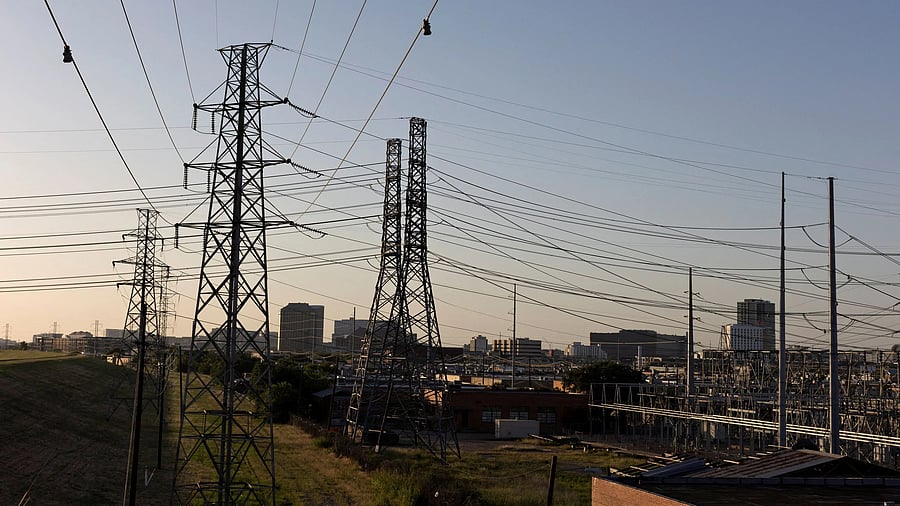
File photo for representational purpose.
Credit: Reuters photo
Mumbai: As all regions of India face intense heat which is pushing its electricity demand to record highs, timely investment in building infrastructure conducive to renewable energy could be the key to solve the dual problem of heat and emission laden power supply, says a new study.
The report by Climate Trends and Climate Compatible Features - ‘Breaking the cycle’, analyses decadal changes in temperatures, heatwaves, its impact on electricity demand and evolving policies that deal with rising temperatures and its impacts.
The report compares data on rising temperatures, heatwaves and electricity demand and shows that they are no longer separate problems but interconnected threats. Summer peaks are amplifying stress on the grid and power system, worsening emissions, and challenging both infrastructure and public health systems simultaneously.
The number of heatwave days with temperatures exceeding 40 degrees Celsius rose sharply in the latter half of the decade, with 14 states recording a 15 per cent increase in summer heat intensity between 2015 and 2024.
In parallel, India’s power system expanded significantly, growing from 285 GW in 2015 to 461 GW in 2024. Renewable energy more than doubled from 84 GW to 209 GW, while fossil-fuel capacity also rose from 195 GW to 243 GW. While coal continues to be the base energy source, the rising share of RE is slowly elbowing it out.
RE generation saw an impressive 121 per cent rise over the decade while fossil fuel generation rose by 50 per cent during the same period.
Highlighting converging solutions, the report emphasises, there is an urgent need for investments in storage solutions, flexible generation, resilient smart grids and demand-side management to increase the penetration of renewables across the country.
“Our research shows that increase in temperatures across India has consistently increased electricity demand predominantly for cooling needs, resulting in further dependence on fossil fuels. Meeting the summer power demand surge with fossil fuels has led to more emissions and air pollution, exacerbating climate change and worsening the health crisis. It’s important to break this cycle to avoid disproportionately impacting the financially disadvantaged and vulnerable sections of our society that bear the brunt of rising temperatures and heatwaves,” said Dr Manish Ram, CEO at Climate Compatible Futures.
Aarti Khosla, Director, Climate Trends said, “The findings show that India’s heatwaves and power shortages can no longer be treated as separate crises. They are converging. It is clear that the only durable way out is to urgently upgrade our grid, invest in storage and enable flexible, climate-resilient electricity systems. Without these investments, every summer will lock us deeper into fossil dependence, negating the progress made on transition with higher emissions and worsening public health impacts. Breaking this cycle is not just a climate imperative — it is an equity imperative for millions of Indians who are the least responsible but the most vulnerable to extreme heat.”
Power demand surge due to high temperature and heatwaves have a disproportionate impact on rural regions compared to urban. Vulnerability of low-income populations to heat and energy access disruptions is explored further in studies analysing heatwave impact on mortality, which highlight existing socioeconomic disparities, and scoping reports detailing the stress on India’s power sector infrastructure.
Central and Eastern states such as Madhya Pradesh, Jharkhand, and Chhattisgarh faced an average of 50 heatwave days every year between 2014 and 2024. Northern states such as Delhi, Uttar Pradesh, Punjab, and Haryana were identified as the most affected regions, exhibiting the sharpest increase in summer temperature surges.
Analysis also noted temperature escalation in the Himalayan states such as Uttarakhand which saw 11.2 per cent and Ladakh 9.1 per cent indicating increase in annual summer temperature in 2024. Uttarakhand had the most notable increase in heatwave days, from 0 heatwave days in 2023 to 25 heatwave days in 2024 reflecting growing reach of extreme heat into previously moderate regions.
India’s average annual temperature increased by 0.65 degree Celcius in 2024 compared to 1991-2020 baseline. The increase in summertime temperatures added close to 9 per cent of power demand surge during peak heatwave months of April-June 2024 resulting in emissions of 327 MtCO2.
The cumulative increase in fossil-based power consumption during summertime over the last 10 years resulted in 2.5 GtCO2 emissions, underscoring the climate challenge that India faces as it meets growing cooling demand.
India’s growing deployment of climate policies across power, transport and residential sectors, did ensure that up to 440 MtCO2 emissions were saved between 2015-2020, according to research.
The report also analyzed existing heat action plans across states, cities, and districts. Only four states, three cities, and one district currently integrate renewable energy measures such as solar-powered systems or battery backups into their Heat Action Plans (HAPs), exposing critical policy gaps in linking climate adaptation with energy resilience.
Existing HAPs lack comprehensive integration of energy and electricity planning. Future frameworks must include renewable backup systems, demand forecasting models, and urban cooling strategies to enhance preparedness and energy resilience during heatwaves.
Recent studies released by Ember and CREA highlight how India could reduce its dependence on fossil fuel for power generation. Ember’s latest report highlights how meeting 2032 power capacity targets as outlined by India’s National Electricity Plan would take away the need to build more coal power plants beyond what is already under construction.
And CREA’s report highlights how coal power generation in India could peak and decline if India were to install 50 GW of annual renewable energy capacity until 2035.